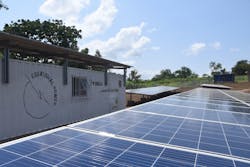Will Utility Partnerships in Minigrid Projects Help Overcome Electrification Barriers in Uganda?
In Uganda, numerous challenges stand in the way of providing reliable electricity. But a pilot minigrid project aims to help overcome the roadblocks.
Most utilities are government owned and lose money. In fact, only two utilities of the 39 in sub-Saharan Africa yield a positive cash flow, and they are privately owned, said Sumaya Mahomed, the Uganda director of Power for All, a nonprofit organization that promotes renewable, decentralized electrification. Utilities lose money, in part, because they’re not managed well, they’re inefficient, and they don’t communicate well with customers and potential customers.
What’s more, the existing grid, which is based on hydropower, isn’t reliable. Much of sub-Saharan Africa experiences transmission and distribution losses as high as 50% and service interruptions of more than 500 hours per year in some countries.
The pilot project, funded by a grant from The Rockefeller Foundation, intends to show a better route to electrification. In the project, commissioned a few weeks ago, a utility has partnered with a renewable energy company and other organizations on a solar minigrid in Kiwumu, Uganda, that will provide power to local businesses and is now serving about 300 homes. In addition, the project will offer support aimed at helping local businesses grow, said Mahomed. It is not now connected to the main grid but is expected to be interconnected in June 2022.
A virtual commissioning event is scheduled for 3 p.m. to 4:30 p.m. Eastern Africa Time June 28.
Rare utility partnership
The project’s partners include Power for All, Equatorial Power, Energrow, East African Power, utility Umeme Uganda and The Rockefeller Foundation.
The most unusual aspect of the project is the inclusion of Umeme Uganda. Utilities and the private sector rarely communicate or collaborate on electrification projects. They view each other as competition.
“Regulation to date has treated these industries in a mutually exclusive manner, limiting the ability for these sectors to collaborate and innovate. That is why you do not see many cases of utilities’ partnership with a renewable energy company,” said Mahomed.
In this effort, the developer, Equatorial Power, will own and operate the minigrid, and Umeme Uganda will provide distribution assets — paid for by the grant — and a payment platform for customers. This is expected to build customer confidence because the platform looks like the system utilized by the utility, Mahomed said.
The minigrid includes 40 kW of solar and a 140-kWh battery that can power more than 360 homes, some businesses and street lighting. The microgrid’s anchor business load is a containerized milling and dryer unit that provides agricultural services to farmers. This will require about 25% of the power produced by the minigrid. East African Power is the developer and operator of the milling and drying units.
A goal is to electrify 50% of area businesses.
In addition, Energrow, a financing entity, will help local businesses expand. For example, Energrow might help finance the purchase of a television for a bar that would allow people to watch soccer.
Keeping politics at bay
One of the aims of the project is to overcome political barriers to installing minigrids. In the region, electricity is synonymous with politics, said Mahomed.
“A number of issues can come up. If an individual has an agenda, that agenda can turn large numbers of people against a project,” she said.
It’s critical to find leaders in a community who can introduce and explain minigrid projects in ways that garner support, she added.
This project was launched in late 2018 with a workshop funded by The Rockefeller Foundation aimed at exploring whether minigrid companies could partner with utilities. Umeme Uganda expressed strong interest in participating.
One of the most important lessons to date has been the importance of ensuring that the minigrid operators communicate well with potential customers, said Mahomed.
“The way that the customer gets onboarded into this journey of accessing power is important,” she said. Renewable energy companies work more proactively to recruit customers and are more customer-centric than utilities. Traditionally, the government powers up a facility and then hands operation to a public utility. The utility doesn’t actively seek new customers, she said.
In the region, electricity is synonymous with politics, said Mahomed.
To replicate this project, it’s important for the partners to push for regulations that would spur innovation and facilitate the process of developing minigrids. Lack of regulations has made the process difficult. The utility and minigrid developers are very interested in pursuing additional minigrid projects in Uganda and the rest of the continent.
Uganda recently published regulations for isolated minigrids, which is a step in the right direction. But there’s more to be accomplished on the regulatory front. The partners continue to educate regulators about how regulation affects innovation. For example, right now, there’s no application process for minigrid developers.
“There’s no document in existence for something like this. The systems and processes need to be developed,” said Mahomed.
For Mahomed, the minigrid project demonstrates how the numerous challenges to electrification in Uganda and sub-Saharan Africa can be overcome. “We are showing that utilities can partner with renewable energy entities and it’s possible to educate the government.”
Track news about minigrids in Sub-Sahara Africa. Subscribe to the free Microgrid Knowledge Newsletter.








